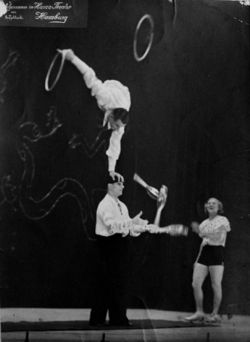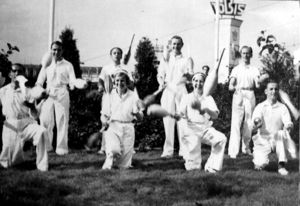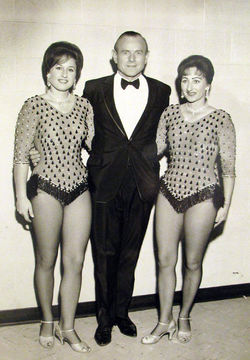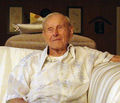Walter Houc
From Circopedia
Juggler
Compiled by Dick Franco — Edited by Dominique Jando
The Three Houcs were what was known as "a working act." They stayed busy for more than five decades, presenting their juggling routines in some of the most prestigious variety theaters and circuses in the world, as well as on television and on film. In its several incarnations, the act always featured Walter Houc, working at various stages with his brother, sister, wife, and daughter. As February 2011 marked Walter’s 100th birthday, Dick Franco conducted an interview of him over several days in July 2010. This biography has been compiled from Walter Houc’s own recollections.
Apprenticeship
Walter Houc (1911-2013) was born Walter Hauck on February 9, 1911 in Breslau, Germany (today Wroclaw, in Poland) in a family of performers.His father, Ernst, was an acrobat who worked in open-air arenas. Ernst and his wife, Anna, had two other children: Frederick (Fritz, 1908-1939), and Alfrieda (1912-1984). Ernst began to train his children in acrobatics as soon as they were able to learn; when he was eight years old, Walter started working as an acrobat with his father, who then built a trapeze act for his two sons.Walter remembered that he was very slim when he started his trapeze act. The brothers were working very high, and their father was standing underneath, watching them. Fritz and Walter used safety straps on their wrists and ankles, which were designed to stop them before hitting the ground in case of a fall. One time, Walter fell and he heard a loud crack: it was the sound of his safety breaking. His father was a very strong man, and he somehow was able to catch Walter before he hit the ground; he had saved his son’s life.
Later on, Ernst opened his own traveling arena, and the siblings made a flying actAny aerial act in which an acrobat is propelled in the air from one point to another. and a perch act to fill up the show. The kids practiced three to four hours every morning, which indeed put a lot of stress on them. Their father was very strict: If Walter didn’t work hard enough, Ernst would give him a solid "rap" on the head. Indeed, like many circus performers of his generation, Walter felt that life was tough for him as a youth—and yet, like most of them, he acknowledged later that these hard times prepared him for life as an adult: The skills he learned as a youth eventually served him very well.
By 1923, as the family was touring with an arena show, a performer who was doing a swaypoleA high, flexible vertical pole (originally made of a single piece of wood, and today of fiberglass) atop of which an acrobat performs various balancing tricks. act left. The swaypoleA high, flexible vertical pole (originally made of a single piece of wood, and today of fiberglass) atop of which an acrobat performs various balancing tricks. act was the show’s drawing card, and the show owner was understandably worried. Ernst told him, “Don’t worry, my son will do it.” The pole was about twelve meters high, and Walter, who was twelve years old and already a very good acrobat, was able to do more than the original performer, and he made even more success. One night, Walter arrived at the last minute for the act and didn’t see that the prop man had not attached the guy lines properly. Up to the pole, he swayed back and forth over the audience until the pole continued to sway in only one direction... Luckily, Walter was able to quickly slide down to safety! The acts he performed were not only physically hard, but also relatively dangerous.
Juggling Beginnings
When Walter was about fifteen, the Hauck family appeared at the Liebich Theater—a well-known variety theater in Breslau, the Haucks’ hometown. They were performing a free ladderUnsupported vertical ladder on which acrobats perform balancing and/or juggling tricks. act billed as Die Anetop (over time, the family would adopt different names according to the act they were presenting). A juggler who worked in the same show gave the Hauck siblings a few juggling props, and Fritz, Walter and Alfrieda began to juggle together. They soon discovered that juggling was much easier on their body than acrobatics: They liked it! They thought it was the best thing they ever did—yet at the beginning their father was against it. Ernst didn’t care for juggling, and didn’t see much artistry in it: He was proud of being an acrobat. He used to tell his children, "Follow in my footsteps, because you will have a good life."
Nonetheless, Walter, Fritz and Alfrieda started juggling with clubs and hoops. They used hoops mostly because they were already using them in their acrobatic act—spinning them on their arms and legs—so it was a familiar prop. They practiced every morning. Then Walter heard that there was an acrobatic juggling act appearing at the famous Wintergarten in Berlin—an Italian act with four brothers and sisters. He got a train ticket and went to see the act: He loved its combination of acrobatics and juggling, and decided that this was the style of act the Haucks should pursue.Being already proficient acrobats, Fritz, Walter and Alfrieda quickly learned to combine acrobatics with juggling. For instance, Walter balanced on one hand on the head of his brother, spinning hoops on his feet and on his free hand, while Fritz was juggling clubs as he was turning around. Yet, most of their work consisted of clubA juggling pin. passing. The siblings were very anxious to learn more about clubA juggling pin. passing, and they regularly went to see other juggling acts that performed this technique.
One day, around 1930, the director of the small nightclub in Essen, Germany, where they performed their acrobatic act, observed them practicing their juggling routine. He loved what he saw: Their act was a novelty—a different kind of act that was rarely seen in Germany. The director suggested they do their juggling act instead of their acrobatic act in the show. The audience loved it, and from that day on, juggling became the Hauck siblings’ main act. They still continued performing their acrobatic act however, which was still in demand.
Fritz was not as good a juggler as Walter, who was, in his own words, "a fanatic." He trained every day with clubs, and sometimes with oranges, because they were the right size and weight for juggling. The Haucks constantly tried new tricks; in one, Alfrieda stood in her high heels on Walter’s head, while he passed clubs with his brother. The heels on her shoes were painful on Walter’s cranium, but the audience loved the trickAny specific exercise in a circus act., so they kept it.
During an engagement at the Wintergarten in Berlin, where the Haucks had been hired for their acrobatic act, Walter showed the juggling act he did with Fritz and Alfrieda to Ludwig Schuch, the Wintergarten’s director. Schuch, who was indeed a savvy judge of circus and variety acts, liked to see young artists try new things, and he made a contract for their juggling act right away. Berlin’s legendary Wintergarten Theater was the epicenter of the European variety scene between the two World Wars, and the Haucks’ juggling act was definitely launched.
From Sechs mit die Keulen To The Houc Duo
Hence the Haucks’ juggling act became much sought after, and they quickly established their name in the business. They worked at the Scala Theater in Berlin—the great rival of the Wintergarten—and in all major "variete" shows around Germany, of which there were plenty. They also performed in circus, principally in buildings, such as circus Kronebau in Munich. Live entertainment was flourishing then and the competition between acts was fierce, but the Haucks’ juggling act remained in great demand because it was the only act at the time that combined top quality juggling with excellent acrobatics.
In Berlin the Haucks worked with another juggling act, The Three Lederers—Arthur, his wife, Hanni, and their son, Heinz. Arthur Lederer had in mind to build a juggling troupe with six people that he was to call Sechs mit die Keulen (Six with Clubs), and he asked the Haucks if they would like to partner with the Lederers. The show in which they were was a long-running one, and the Lederers and the Haucks had time to practice together and build the new act between performances. There were no big juggling troupes in Europe in those days: Most of the time, he few ones that appeared quickly split into smaller groups because each individual wanted to make more money.The new troupe got work immediately, and opened at Circus Kronebau in Munich. Walter liked that big act because they worked only with clubs: To him, it was easy just to throw clubs. And their clubs were inflatable! Heinz Lederer was the inflatable clubA juggling pin. maker; he also built lighted electric clubs that changed color while they juggled in the dark. Unfortunately, Heinz Lederer and Fritz Hauck didn’t get along, and after they had worked practically all the big venues together in Germany, the Haucks and the Lederers decided to split up, and Walter, Fritz, and Alfrieda reverted to their original juggling-cum-acrobatics act. At Alfrieda’s suggestion, the act was renamed The Three Houcs: It sounded better than the German-sounding Hauck for engagements outside Germany at that point in time.
Then Germany began invading parts of Eastern Europe, which would soon lead to WWII. Fritz was the first of the brothers to be called to military duty. Walter and Alfrieda continued to perform as a straight juggling duet, without acrobatics: Fritz had been the "understander" in the act and most of the acrobatic tricks couldn’t be performed without him. Sadly, Fritz would never return to the act; he was killed in 1939 in Czechoslovakia. In June 1940, Walter married Ingrid Mossea (1929-2009). She didn’t come from a performing family but nonetheless, Walter taught her to juggle. This took about one year, after which Ingrid was able to join the act, which was billed as The Three Houcs again—an attractive trio with two girls in it, which is always a good selling point!
But it didn’t last long: Walter, in turn, was called to service in the German Army. Alfrieda and Ingrid continued to work as a duet for as long as it remained possible. In 1945, Walter was taken prisoner by the Allied forces, and sent to a POW camp in France, where he would spend three miserable years. (There were about 750,000 German POW in France, many of them sent to forced labor and kept in a condition close to slavery.) Together with some fellow performers who shared his circumstance, Walter formed an artistic group that performed for the other prisoners and the public at large. It gave them a sense of purpose and also a good way to keep their skills sharp until their anticipated return to a normal life.
The Three Houcs in America
When Walter was eventually freed in 1948, he couldn’t return to Breslau: The city, now known as Wroclaw, had been returned to Poland, where it had originated before shifting its national identity several times over the centuries. Instead, the Haucks settled in Hamburg; at long last, Walter met his three-year old daughter, Ursula, born during his captivity, and he rejoined the juggling act his sister and his wife had revived after the war, and which again could be called a trio.Most of Germany’s major cities laid in ruins; very few variety theaters were still standing&mdah;and they were by and large unable to resume their pre-war activities. Walter, his wife and his sister found a lot of work in England, where circus and variety were thriving right after the war. The Three Houcs’ name was not German sounding, which was good for business in Europe in the post-war era. Over the years, the Houcs appeared at the Palladium in London, the Tower Circus in Blackpool, the Kelvin Hall Circus in Glasgow, as well as the Cirque Medrano in Paris, the Tivoli in Copenhagen, and many other important venues.
In 1954, The Three Houcs were introduced to an agent of the William Morris Agency, who brought them to the United States for the first time. There they began to work in variety shows with headliners such as Danny Kaye and Jerry Lewis. The agency also booked them with the Ed Sullivan Show, then the top TV variety show in America, which was indeed a very good exposure. They would appear in the Ed Sullivan Show four different times—with different parts of their act, since visual acts were always cut to a bare minimum in order to fit the show schedule. The Houcs returned regularly in Europe, and for some ten years, worked back and forth on both continents.
Walter appreciated the fact that he could buy many goods in America and bring them back home to his parents, who had retired. The Three Houcs were making good money. They were never out of work: as soon as they had secured a contract in Europe, they had another one waiting in America, and vice versa. Finally, in 1963, Walter and Ingrid decided to settle in the United States. Then, Alfrieda got married and settled in Germany, where she bought a house with her American earnings. Ursula, who had become a proficient juggler, replaced her in the act.
The Three Houcs played places like Ciro’s of Hollywood; the Palmer House and the Shubert Theater in Chicago; Radio City Music Hall, Madison Square Garden, and the Latin Quarter in New York City; and the Flamingo in Las Vegas. They also worked the Harrah’s casinos in Reno and Lake Tahoe, where they appeared on shows with stars such as Jack Benny, Helen O’Connell, and Jimmy Durante. They also did circus dates, and toured with the Polack Brothers Circus and, for two seasons, with the Clyde Beatty Circus, among others.
A Long Retirement
Walter’s policy was to save fifty percent of everything he earned to cover the time when he might be out of work—but he was never out of work. This policy has ensured him a comfortable retirement for more than forty years—which has been lucky considering his exceptionally long life. His tip to young performers: “Save half of what you make. It’s a good policy for any performer to follow.”
Walter truly enjoyed show business. During his working years, he never stopped practicing; sometimes in Spain, where performances—in circus, variety, theater, as well as in nightclubs—are given notoriously late in the evening, the Houcs would finish work at 1:00 am, but were up at nine o’clock in the morning for practice. They took pride in their being artists. They loved to do their juggling act, and were proud of the prestigious venues in which they had appeared. They had made indeed a very good name for themselves, and were stars in their field. Said Walter, "I think a big factor in our success was that the girls looked very good, and I was not so bad looking, either. It's a big factor that you have a good act and you're looking good, too, and people are happy."Ursula eventually left The Three Houcs when she got married. Ingrid and Walter continued to work as a duo, simply billed as The Houcs. They did their clubA juggling pin.-passing act, but many shows now asked for a second act as well—something that never happened when they worked as a trio. So Walter created a plate-spinning act, and combined his plate spinning with some other skills. The act was successful; presented as Walter & Ingrid, it developed into a good-quality second act.
Walter was seventy-two when The Houcs retired in 1983. He sold all his props to a collector, a circus fan from Jackson, Mississippi, who also told him about juggling conventions, but Walter never attended. He never juggled again after his retirement. In 1998, at age eighty-seven, he had an emergency triple bypass; the operation saved his life—and for a long, long time. Then, on September 29, 2004, Ingrid, Walter’s wife of sixty years, and his partner for four decades, passed away. It was, Walter said, “the hardest moment of my life.”
In 2010, Walter Houc mused: “Other than a few things, I had a great life, and I now have a good, comfortable retirement, independent in my own home at age 99. Many people suggested I move to a retirement facility where they have services to help me… It might be right for some people, but I think I would die in there. I like my home. I have been here many years and people can easily visit me. I value my independence and I’ll stay here for as long as I can… I guess what I want to share with people is to be happy, eat good, and have a nice, exciting life.”
Walter remained very active during his long retirement, visiting old friends, making new ones, always eager to share memories of his career in show business—the world he had always known and cherished above all. Then in late October 2013 he was suddenly taken ill. He passed away a few days later, on October 25, one of his many friends, the clown Chuck Sidlow, at his side; the great juggler Dieter Tasso had made a last visit a little earlier. Walter Houc was 102 years old.
See Also
- Video: The 3 Houcs, juggling act, on The Ed Sullivan Show (1967)

























